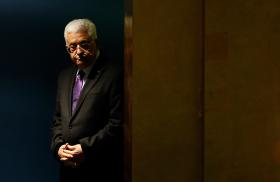
- Policy Analysis
- Fikra Forum
After Withdrawal, Soft Power and a Safe-Zone Can Still Help U.S. Interests in Syria

On December 19, 2018, the Trump administration surprised the international community by announcing the withdrawal of U.S. forces from Syria. While the Pentagon has begun crafting a strategy for withdrawal, the timeline for the departure is uncertain and could stretch over several months. With the process already in motion, Syrian President Bashar al-Assad continues to consolidate his power against opposition forces, while the Islamic State (IS) has been able to hold onto some territory in Syria
Against this backdrop, the current U.S. administration ought to focus on what tactics its can still implement to achieve its four major objectives: preventing a resurgence of IS; stopping Iran, Russia, Turkey, and Hezbollah from controlling all of Syria; developing a long-term strategy to protect American allies on the ground; and putting an end to the Syrian civil war through UN-sponsored peace talks. The United States currently has the opportunity to install mechanisms that would help in achieving these objectives while ensuring the safe departure of its troops, centering on permanent measures to protect its allies and soft power efforts to promote long-term stability in Syria.
Short-Term Military Adjustments
To ensure the safety of U.S. troops during the withdrawal, the Pentagon should set up observation and monitoring points throughout northeastern Syria, especially in majority-Kurdish regions. These observation and monitoring points would serve a dual purpose: to ensure the safe withdrawal of U.S. troops and to ward off attacks on allies like the Syrian Democratic Forces (SDF) from Turkey, Syrian extremist militias, the Assad regime, or IS.
Indeed, rather than a complete withdrawal, the United States could do much to further its objectives in Syria by stationing approximately 600 soldiers to these monitoring points in northern Syria once the main withdrawal is complete. This small force would not only further prevent Turkey and other rivals from targeting Syrian Kurds but would also serve as additional U.S. bases designed to ward off Iranian expansionism in areas currently controlled by U.S. allies alongside the al-Tanf base in the south—a base the Trump administration is potentially keeping open after the main withdrawal.
In order for any later soft power efforts to be effective, U.S. policy in the next few months should further guarantee that Syrian Kurds will remain secure and politically free after the withdrawal. The most effective policy for this assurance is establishing a safe or no-fly zone in northeastern Syria under international auspices with the help of the United Kingdom, France, Saudi Arabia, and the United Arab Emirates. This safe-zone will counter Turkish plans to establish its own sphere of influence in northeast Syria, which threatens the region’s Syrian Kurds.
An internationally monitored safe-zone, along with strategic U.S. bases, would also do much to thwart Tehran’s plans to form a "Shiite crescent" that would allow it exert influence all the way from Iraq, through Syria, and into Lebanon. In particular, Syrian Kurds in the security zone could serve as a buffer against Iranian expansion, cut off support for Hezbollah, and stop Tehran from accessing oil and gas energy sources.
Long-Term Soft Power
Beyond short-term military adjustments designed to support institutional structures that align with U.S. regional objectives, the United States should further advance its interests by turning to long-term soft power investments to limit the influence of its ideological adversaries. While institutions in northeastern Syria currently act as a bulwark against these forces, sustained engagement is necessary to ensure this position can be maintained.
Development aid is an especially needed soft-power measure that can also help the United States promote its interests in Syria. As Syria is a country rich in natural resources, U.S. government agencies such as USAID can send field experts to develop plans to improve the Syrian economic infrastructure in the post-war phase. For instance, aid agencies can help find ways to generate solar and water power and introduce agricultural development plans to increase agricultural production, build irrigation systems, and combat desertification and drought. Visible reconstruction activity will demonstrate U.S. goodwill to Syrians while mitigating similar efforts by Russia, Iran, Turkey, or IS.
These agencies can also assist the Syrian public to take part in the reconstruction process by granting small loans to enable companies specializing in infrastructure to develop. Such programs could generate job opportunities and contribute to the development of Syrian society by helping reduce poverty, armed conflict, and extremism. Moreover, they will give American companies the opportunity to work in Syria and build joint business ventures in the future.
However, economic aid will not be effective without U.S. support of a civil society infrastructure. In order to further safeguard northeastern Syria from an resurgence of IS and take advantage of the efforts the United States has already expended to protect nascent democratic institutions in those areas outside of the Assad regime’s control, the U.S. government should also provide training workshops for political and civil society leaders. In this manner, the Trump administration could help those on the ground further study the foundational elements of democracy, the federal system, elections, human rights, and the development of an inclusive constitution while also teaching innovative ways to combat terrorism.
In addition, Syrians desperately need a new educational system. The U.S. Department of State can help with initiatives that would provide Syrian students with an advanced curricula and textbooks to replace the current materials, which are ideologically-Ba’athist. Sponsoring these educational tools is one of the most effective ways to help Syria’s new generation navigate the current economic and societal challenges of their environment. To help the education sector in Syria back on its feet, such initiatives must be designed to help with the construction of schools that were destroyed by the war and enable American education experts to travel to Syria.
In terms of higher education, extending Fulbright student grants to Syria can help Syrian students whose studies have been interrupted by war, poverty, and terrorism complete some of their education in the United States. To further build cultural bridges between Syrians and Americans, The Department of State could also invite Syrian youths to the United States to participate in leadership programs, media training, and English language programs. Given the precarious nature of Syria’s current educational system, these efforts could have an outsized impact on influencing Syrian students’ views on democracy and preventing Iran from shaping an alternative narrative.
Similarly, U.S. support of independent media outlets accessible throughout Syria is vital to promoting democratic values and boosting the United States’ status in Syria. U.S. governmental media like the Broadcasting Board of Governors (BBG)—the umbrella organization overseeing such media agencies as Middle East News Network (MBN) and Voice of America (VOA)—have a responsibility per their mission statements to assist Syrian journalists in Syria. By broadcasting Syrian voices on radio, television, and other mediums, this exposure can eventually help in creating an independent and professional journalism sector in certain sections of Syria. These U.S. organizations can also hire aspiring Syrian journalists as interns to help them develop skills they can apply later on in their careers.
Given the short-term military and long-term soft power options available to the United States, the military withdrawal from Syria does not need to mean a complete U.S. disengagement from the war-torn country. Through limited presence on the ground, the declaration of a safe zone, and soft power efforts to promote economic, social, and educational recovery, the United States can continue promoting its objectives in Syria.


